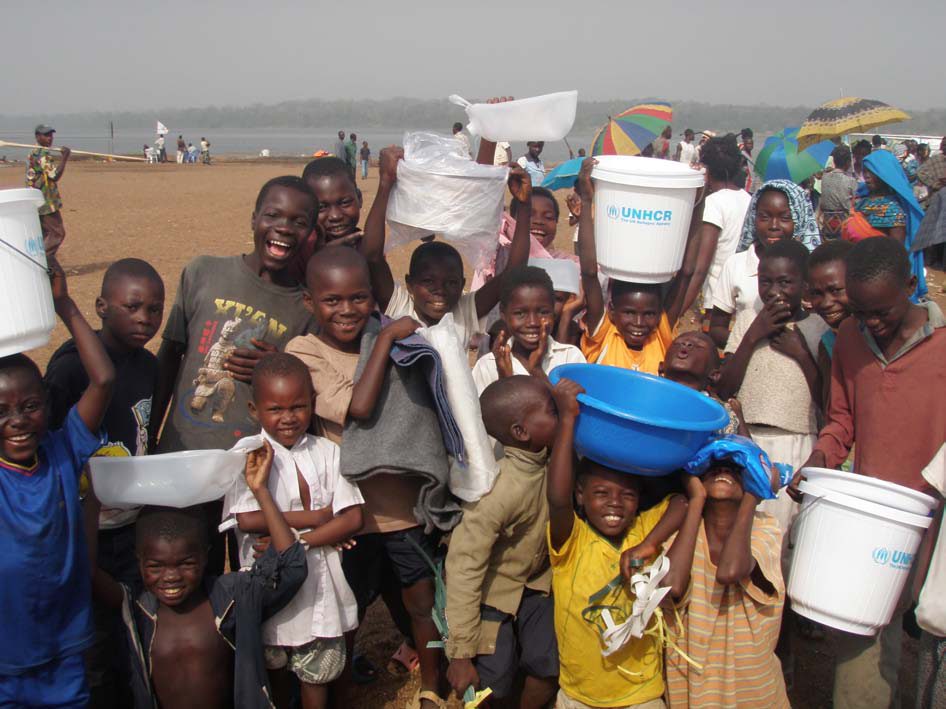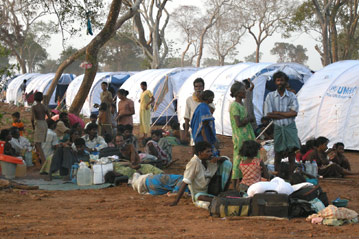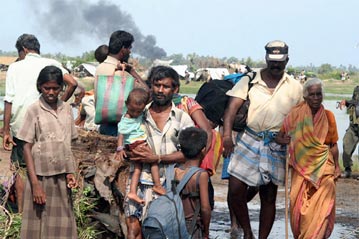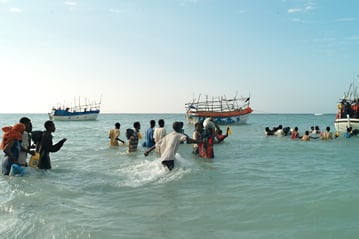Silent towns line Colombia's rivers
Silent towns line Colombia's rivers

PIEDRA CANDELA, Colombia, August 15 (UNHCR) - Only silence can be heard in the once vibrant town of Piedra Candela on Colombia's Bojayá River. The main street, lined with one- and two-storey wooden houses, is eerily empty. Everywhere, there are signs that the town's residents left in a hurry. A child's shoe lies on the street. Inside one house, records are scattered on the floor along with a small bicycle. If most of the houses are empty of furniture and personal belongings, it is not their owners who removed them but the armed groups, who did not waste any time in taking their booty once the inhabitants had fled.
The more than 470 residents of Piedra Candela left in May 2004 following a series of clashes in the area between the Colombian military and irregular armed guerrilla groups that led to the deaths of two residents and the disappearance of eight others. Their story is an all too common one in Colombia, where more than three million people have been displaced in and outside the country's borders in the past 10 years. The sheer scale of the problem presents UNHCR, which is playing a leading role in the protection of internally displaced persons in Colombia, with unique challenges.
According to government figures, which tend to be conservative, one in every eight inhabitants of Chocó is displaced, with more than 80,000 people forced to leave their homes in the past decade. Abandoned towns are scattered along the river banks in this vast region, one of the most humid and biologically diverse on earth. The Colombian military controls the main rivers, the only reliable transport routes, but inland the paramilitary and irregular armed groups control patches of territory, frequently within a short distance from each other.
Many of the internally displaced arrive in places such as Villa España, a shantytown on the outskirts of Quibdó, the provincial capital. Some have been living since 1999 in "temporary housing" built by the Spanish Red Cross and the government's Social Solidarity Network, which is charged with looking after displaced persons. Today, many of the wooden structures are in need of repair. Nearby, the foundations of more permanent structures for the internally displaced lie abandoned.
A landmark ruling last year by the Colombian Supreme Court ordered the government to do more for the country's internally displaced. But helping displaced people is a complex task, not least because of the lack of factual data available. To help the government meet its responsibilities, the UN refugee agency is sponsoring a census to determine the exact number of displaced people in Quibdó. In addition to determining the number displaced, the study is gathering data on their health, occupation and housing conditions. The idea is to provide a solid factual basis to back up demands for better services such as education and health.
"Many displaced people do not register because of ignorance of the law, fear, or a hope that things will get better and they will be able to return home," says Sandra Pacheco, who is working for UNHCR on the census. "These are the people we want to reach."
While just over 1.5 million internally displaced people are currently registered in Colombia, the government estimates many more cases are not known to the authorities and non-governmental organisations believe there could be as many as 3.4 million displaced in the country. The hope is that the census in Quibdó will serve as a model for similar studies in other cities. About 40 percent of Colombia's displaced population live around the country's 10 largest urban areas, where they are often the victims of discrimination and the targets of irregular armed groups. In Quibdó, where an estimated 20,000 displaced have settled, integration is proving difficult.
"Integrating them is important because from the moment they arrive, they are stigmatized as displaced," Pacheco says. "For them, adapting to Quibdó is very difficult because they come from rural areas."
Daisy (not her real name) is one of the displaced from the Buey River town of La Vuelta who found temporary shelter in the headquarters of an Afro-Colombian federation in Quibdó. Although the building has a large kitchen, the women cook on a patio because there is no gas or running water. About 60 people have been living in the building for more than two months because promises of finding them more adequate housing have not been kept.
"When it rains we can't cook because we cannot light the fire," says Daisy. "Some of my friends want to return because they are unhappy here, but things back home are still in bad shape. Too many armed men."
Armed groups originally established themselves in Chocó because of its strategic access to Panama that facilitated contraband of arms through its extensive river routes. Major forced displacement first took place in the Chocó Department in 1997, when the armed groups began arriving in force in the region. About 800 civilians were killed between 1996 and 2002, according to a report by the Colombian Episcopal Conference of the Catholic Church.
"Some people still dream of returning to their homes," says Wilson Mosquera Sierra, a community leader in Villa España. "But most don't want to return because they don't see adequate security."
Today, more than a year after its inhabitants fled, Piedra Candela remains a ghost town. Only the occasional journalists in search of powerful images dare venture on its deserted streets. Inside the oval-shaped church, a statue of the Virgin Mary is still standing on its pedestal, but the pews are scattered throughout, covered with sand.
"The Church of the Candelaria is where people used to celebrate," says Pacho, who returned to visit his abandoned village with a group of journalists. "The truth is that we lived here without any worries."
But now, with a climate of conflict and fear, any return would be hazardous, leaving displaced people like Pacho hanging onto shreds of memories from a distant and carefree past.
By Eduardo Cue in Piedra Candela, Colombia








